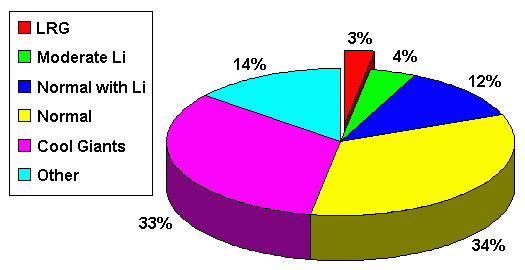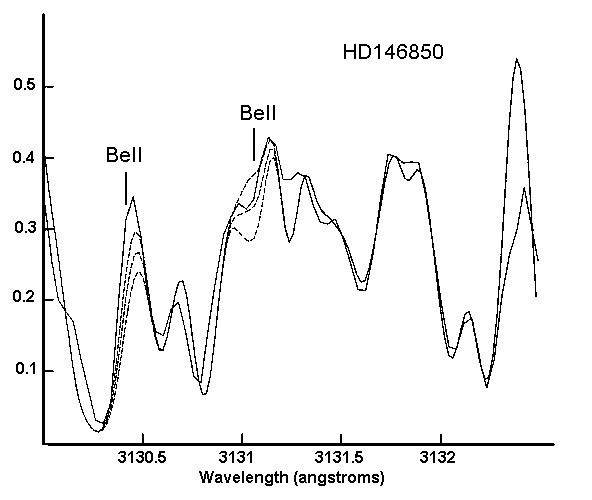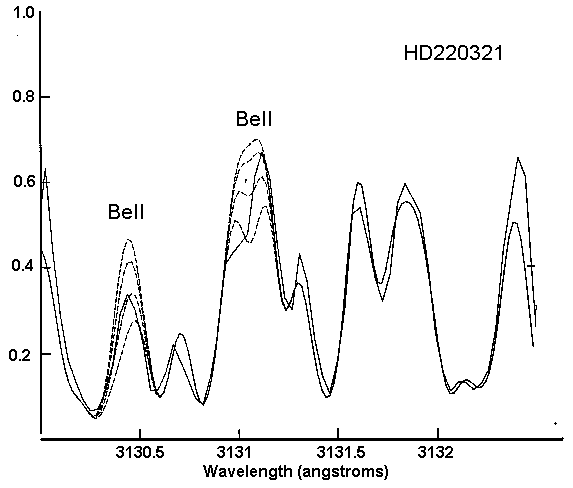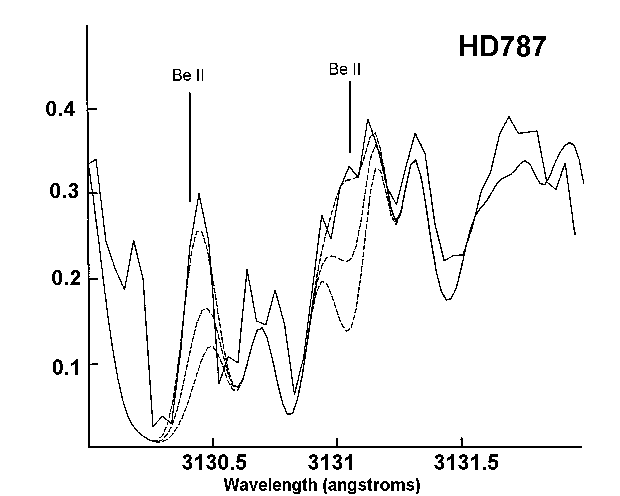
SPECTROSCOPIC ANALYSIS OF LITHIUM-RICH GIANTS
Bruno V. Castilho bruno@orion.iagusp.usp.br
Jane Gregorio-Hetem jane@iagusp.usp.br
& Beatriz Barbuy barbuy@orion.iagusp.usp.br
UNIVERSIDADE DE SÃO PAULO (IAG/USP)
Caixa Postal 9638 - São Paulo - SP, 01065-970 - BRAZIL
| Abstract | Scientific Aim | Goals | Selection Criteria | Observations | Beryllium Abundances | Results | Individual Comments | Conclusions | References |
Lithium-rich giants (LRG) are rare and quite unknown, but very interesting as they could be one of the main agents of increasing the lithium abundance in the interstellar medium.
The actual abundances reach ten times higher than the primordial value. The characteristics of the LRG are in general the same of normal red giants, but they have much more lithium than could be expected.
We have developed a long-term project to better understand these objects, by searching them (in order to increase the number of identified LRG) and also by studying their nature, with detailed spectral analysis.
In a previous work we prepared a list of candidates, based on IRAS colors typical of LRG and we have obtained medium-resolution spectra in order to confirm their nature. We found five LRG, as also other six giants with moderate lithium-line. Before that work, only about 20 LRG were known.
According to theoretical models, giant stars have their Li strongly diluted. The high Li abundances found in red giants can be explained by two ways:
(i) the original Li was not destroyed in some stars,
or, in other hand
(ii) it could exist a process of Li production during the star evolution
Some authors, as Smith & Lambert (1989, 1990), and Sackmann & Boothroyd (1992, 1997) have argued that Li could be produced in red giants, in a given evolutionary stage.
Several LRG groups are found in other regions of the IRAS colors diagram, likely they were following evolutionary tracks, possible due to mass loss (Castilho 1995, de la Reza et al. 1996).
By doing a systematic search, we intend to increase the number of identified LRG (only 20 of them were known previously)
We selected a sample of the best candidates and we have obtained spectra, in order to confirm their nature, by looking for strong Li 670.8 nm line.
We intend to deeply analyzing each LRG detected by us, in order to better understand their high Li abundance and verify if they are numerous enough to explain the Li enrichment in the Galaxy.
Based on IRAS data, we evaluated the infrared emission of the LRG studied by Brown et al. (1989). We verified they are concentrated in a well-defined region in the colors diagram [25-12] x [60-25], respectively in the ranges -0.7 to -0.3 and 0 to 0.25.
We searched in the IRAS Catalog all the sources having colors inner these limits, by excluding those without good quality fluxes, or those ones identified as spurious objects. A list with 280 candidates, distributed in the whole sky, was prepared.
We obtained medium-resolution spectra in the range l l 650-680 nm, in order to detect mainly the Ha e LiI (l 670.782 nm) lines. The observations were performed in Brazil, Chile, and France:
|
Observatory |
telescope |
spectrograph |
resolution |
| LNA (Pico dos Dias) | 1.6m | Coudé | 0.3 Å |
| ESO (La Silla) | 1.5m | Boller&Chivens | 1.0 Å |
| OHP (Haute Provence) | 1.52m | Aurelie | 0.2 Å |
Almost 157 IRAS sources were observed. We obtained spectra for 164 stars, (some candidates have two or more optical counterparts).
We classified the stars according the strength of the Li line, estimated as function of the ratio of equivalent width (W) of the Li and CaI (l 671.768 nm) lines:
| W(Li)/W(Ca) |
>1 |
0.5 - 1 |
<0.5 |
| Lithium | strong | moderate | weak |
Figure1. Distribution of our sample in several classes

Table 1 Stars with strong Li (l 670.782 nm) line
| IRAS | identification | Type | mV | W(Li) | [Li]/[Ca] |
| 07559-5859 | HD65750, SAO235638 | M0III | 6.3 | 0.31 | 1.41 |
| 16161-1445 | HD146850, SAO159846 | K3III | 7.2 | 0.37 | 1.32 |
| 18241-1443 | GCSS557 SRa | 10.4 | 0.21 | 0.95 | |
| 18585-0430 | HD176588, SAO 142919 | K2III | 7.1 | 0.27 | 1.00 |
| 19012-0747 | 0.41 | 1.71 |
Table 2 Stars with moderate Li
| IRAS | identification | Type | mV | W(Li) | [Li]/[Ca] |
| 00483-7347 | 0.10 | 0.53 | |||
| 06215-0902 | HD44889, SAO133209 | K0 | 8.2 | 0.18 | 0.60 |
| 10204-6135 | HD90082, SAO250932 | M3 | 7.5 | 0.20 | 0.83 |
| 11024-6241 | HD96195, SAO251247 | K5 | 8.0 | 0.17 | 0.61 |
| 19038-0026 | 0.13 | 0.77 | |||
| 19049-0234 | HD 178168 | K5 | 9.0 | 0.12 | 0.53 |
We performed observations of Be II l3130.414 and 3131.058Å lines in two LRG and one Li-poor giant with CASPEC (R=32000) at the ESO 3.6m telescope.
Using spectral synthesis we show that for the three stars Be was very depleted (>90%) from the initial ISM value ~logN(Be)=1.5. This result implies that the original Li in these stars must have been almost completely destroyed, as in the case of HD220321; and that the high Li abundances for the Li-rich red giants are due to Li production in these stars.
Figure 2. Fit for HD146850: logN(Be)=0.0, -0.5, -1.0

Figure 3. Fit for HD220321. logN(Be)=0.5, 0.0, -0.5, -1.0

Figure 4. Fit for HD787: logN(Be)=no Be, 0.0, -1.2

IRAS07559-5859: HD65750 is oxygen rich, has 5 M¤ and a large circumstellar shell of gas and dust, as showed by an I band obtained by us at LNA.
IRAS10204-6135: HD90082 shows molecular features affecting a better determination of the Li equivalent.
IRAS16161-1445: HD146850 was studied by Castilho et al. (1995), determining log N(Li) = 1.6; [Fe/H] = -0.3 and solar values for the ratios of O, Mg, Ca, e Ti, relative to Fe.
IRAS18241-1443: SS577 is an S type star (Kershbaum & Hron 1992), which circumstellar material was studied by Chen & Kwok (1993). The low-resolution spectrum obtained in the 8 a 22 m m range does not show special features.
IRAS19012-0747 e IRAS19038-0026: They have weak optical counterparts (mV ³ 10), without stellar parameters previously known. They are probably K type stars, as it is indicated by their spectra.
Brown et al. (1989) studied a sample of 644 red giants (G-K types): only 1.5% of them are LRG and are concentrated in a special locus of the IRAS colors diagram [l i-l j]=log(Fl i/Fl j), where l =12, 25 and 60 m m.
We prepared a list of IRAS sources with colors similar to the Brown’s LRG and developed spectroscopy for 164 candidates.
Based on the comparison between the equivalent width of the LiI and CaI lines, we detected 5 stars with strong Li line and 6 with moderate Li. 20 stars are normal giants, with weak Li line and 56 show no Li. Among other kind of objects, 54 stars show strong TiO bands.
Some LRG are found in other regions of the IRAS colors diagram (as the example of the LRG in the T Tauri locus). It is possible that LRG do not form a special class of objects, but they could represent a given evolutionary status of normal stars.
In order to better understanding the evolutionary tracks in the IRAS diagram, we intend to enlarge our selection criterion and increase the number of candidates.
As Li abundances in red giants can reach values 10x the ISM value and it seems that all low mass red giants go through a phase of Li production in the RGB, together with an increase in the mass loss, these stars should be a important source of Li enrichment to the ISM.